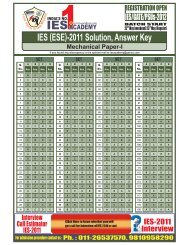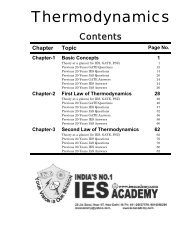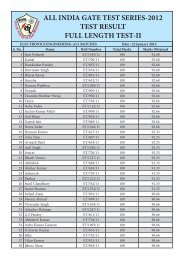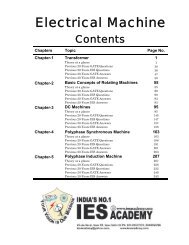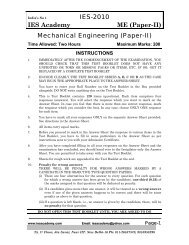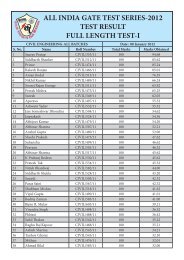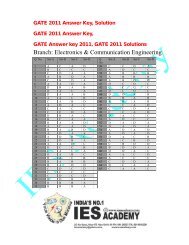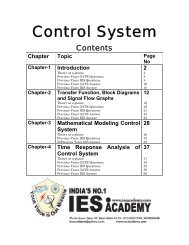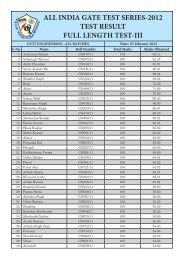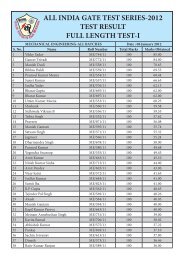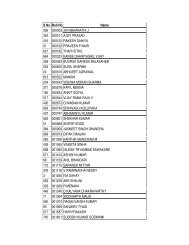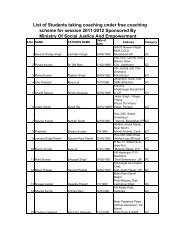IES-2010 IES Academy ET (Paper-I) Electronics Engineering (Paper-I)
IES-2010 IES Academy ET (Paper-I) Electronics Engineering (Paper-I)
IES-2010 IES Academy ET (Paper-I) Electronics Engineering (Paper-I)
You also want an ePaper? Increase the reach of your titles
YUMPU automatically turns print PDFs into web optimized ePapers that Google loves.
India’s No 1<strong>IES</strong> <strong>Academy</strong><strong>IES</strong>-<strong>2010</strong><strong>ET</strong> (<strong>Paper</strong>-I)jω+46−ω + 5jωQ1. A causal stable LTI system S has the frequency response H( jw) =24t4tWhat is the output of S when the input is x( t) e −−= u( t) − te u( t )?−2t −4t ( a) ( 0.5e −0.5e ) u( t) −2t −4t( b) ( e −0.5e ) u( t)−2t −4t ( c) ( 0.5e −e ) u( t) −4t −4t( d) ( 0.5e −e ) u( t)Q2. Consider an LTI system whose response to the input−t −3t −t −4tx( t) = ⎡⎣e + e ⎤⎦u( t) is y( t) = ⎡⎣2e −2e ⎤⎦u( t ).Find the frequency response of this system.1 3 3 3( a) + ( b)+( 4+ jω ) ( 2+ jω ) 2( 4+ jω ) 2( 2+ jω)3 3 1 3c + d +4+ jω 2 2+ jω 4+ jω 2 2+ jω( ) ( ) ( )( ) ( ) ( )Q3. The procedure for interpolation or up sampling by an integer factor N canbe thought of as the cascade of two operations. The first operation,involving system A, corresponds to inserting N-1 zero-sequence valuesbetween each sequence value of x[n], so that⎧ ⎡n⎤⎪x d ⎢ ⎥, n = 0, ± N, ± 2N, ...xp⎡⎣n⎤⎦= ⎨ ⎣N⎦⎪⎩ 0,otherwisejFor exact band – limited interpolation, He ( ω)Determine whether or not system A is:(a) Linear(c) Linear at some points, otherwise non-linearis an ideal lowpass filter.(b) Non linear(d) Can’t sayQ4. A signal x(t) with Fourier transform X(jω) undergoes impulse – trainsampling to generatep∞( ) = ∑ ( ) δ( − )x t x nT t nTn =−∞where T = 10−4If X( jω ) = 0 for ω > 5000π does the sampling theorem guarantee that x(t) canbe recovered exactly from xp( t ) ?(a) Yes(c) Some part of signal can be recovered exactly(b) No(d) Data insufficient.Q5. The following is known about a discrete – time LTI system with input x[n]and output y[n]:(1) If x[n] = ( − 2) nfor all n, then y[n] = 0 for all n.www.iesacademy.com Email: iesacademy@yahoo.com Page-2__25, 1 st Floor, Jia Sarai, Near IIT. New Delhi-16 Ph: 011-26537570, 9810958290



